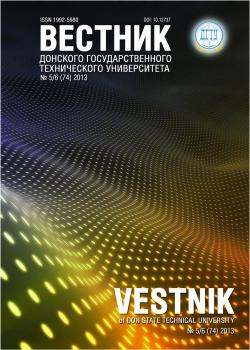The research subject is the technology of generating the multivariable data representation with using separate formation of dimen-sions and measures. The purpose of the study is to provide a full level of the user’s work automation at the formation of new data cubes. In the course of investigation, the following problems are solved: the sequence of generating intermediate data representations is determined; the correctness of these representations is studied; efficient algorithms for generating the representations and checking their correctness are developed. The theoretical basis is the methods of the inter model mapping. Herewith, a classical relational model is used as a source data model, an ex-tended model of the multidimensional data with unbalanced hier-archies in dimensions – as a target one. The work result is the multidimensional data construction technology. Consequently, the results obtained can be used by the analytical departments at various enterprises in processing large data volumes. The pro-posed technology of the multidimensional data formation is the traditional OLAP-technologies development.
hypercube, relational database, OLAP.
Исследование OLAP (online analytical processing — аналитическая обработка в реальном времени) предполагает рассмотрение свойств моделей гиперкубов [1–3] и операций их преобразования [2, 4] с целью анализа данных. Особое внимание уделяется построению иерархий в размерностях [2, 3, 5–7], что позволяет гарантировать корректность операций агрегации данных. В работах [3, 5, 7] рассматриваются нормальные формы для многомерных моделей данных, которые позволяют контролировать неопределенные значения (NULL) в иерархиях размерностей.
В большинстве работ предполагается, что кубическое представление данных должно быть постоянно храни-мым и периодически обновляемым из операционной базы данных (MOLAP — многомерная OLAP) для минимального времени отклика системы на запросы пользователя. Другой подход заключается в динамическом формировании мно-гомерных данных с преобразованием схемы исходной операционной базы данных в «звезду» или «снежинку» (ROLAP — реляционная OLAP). Общий недостаток этих двух подходов — регламентированность предполагаемых операций анализа данных.
1. Vassiliadis, P., Sellis, T. A survey of logical models for OLAP databases. SIGMOD Record, 1999, vol. 28, no.4, pp. 64-69.
2. Pedersen, T.-B., Jensen, C.-S., Dyreson, C.-E. A foundation for capturing and querying complex multidimensional data. Information Systems Frontiers, 2001, vol. 26, no. 5, pp. 383-423.
3. Lechtenborger, J., Vossen, G. Multidimensional normal forms for data warehouse design. Information Systems Frontiers, 2003, vol. 28, no. 5, pp. 415-434.
4. Li, H.-G., et al. Progressive ranking of range aggregates. Data & Knowledge Engineering, 2007, vol. 63, no. 1, pp. 4-25.
5. Lehner, W., Albrecht, J., Wedekind H. Normal forms for multidimensional databases. Proceedings of the Tenth In-ternational Conference on Scientific and Statistical Database Management. Los Alamitos, 1998, pp. 63-72.
6. Giorgini, P., Rizzi, S., Garzetti, M. Goal-oriented requirement analysis for data warehouse design. In Proceedings of the 8th ACM international Workshop on Data Warehousing and OLAP: DOLAP ´05. - Bremen, 2005. - P. 47-56.
7. Mazon, J., Trujillo, J., Lechtenborger, J. Reconciling requirement-driven data warehouses with data sources via multidimensional normal forms. Data & Knowledge Engineering, 2007, vol. 63, no. 3, pp. 725-751.
8. Ullman, J. Principles of database systems. Stanford: Computer Science Press, 1980, 379 p.
9. Maier, D. The theory of relational databases. Rockville: Computer Science Press, 1983, 637 p.
10. Zykin, S.V. Formation of Hypercube Representation of Relational Database. Programming and Computer Soft-ware, 2006, vol. 32, no. 6, pp. 348-354.
11. Zykin, S.V. Dinamicheskie konteksty bazy dannykh relyatsionnogo tipa. [Dynamic contexts of relational-type da-tabase.] Informatics and Applications, 2014, vol. 8, no. 1, pp. 77-88 (in Russian).
12. Redreev, P.G. Postroenie ierarkhiy v mnogomernykh modelyakh dannykh. [Construction of hierarchies in multi-dimensional data models.] Izvestiya of Saratov University. Series Mathematics. Mechanics. Informatics. 2009, vol. 9, no. 4, part 1, pp. 84-87 (in Russian).
13. Casanova, M., Fagin, R., Papadimitriou, C. Inclusion Dependencies and Their Interaction with Functional De-pendencies. Journal of Computer and System Sciences, 1984, no. 28 (1), pp. 29-59.
14. Missaoui, R., Godin, R. The Implication Problem for Inclusion Dependencies: A Graph Approach. SIGMOD Record, 1990, vol. 19, no. 1, pp. 36-40.
15. Levene, M., Vincent, M.-W. Justification for Inclusion Dependency Normal Form. IEEE Transactions on Knowledge and Data Engineering, 2000, vol. 12, no. 2, pp. 281-291.
16. Aho, A.-V., Hopcrof t, J.-E., Ullman, J.-D. Data Structures and Algorithms. Reading: Addison-Wesley, 1983, 427 p.
17. Miller, L., Nila, S. Data Warehouse Modeler: A CASE Tool for Warehouse Design. Thirty-First Annual Hawaii International Conference on System Sciences, 1998, vol. 6, pp. 42-48.
18. Zykin, S.V. Automation of the interface formation between multidimensional and relational representation of the data. Taylor, J.-R., ed. Relational Databases and Open Source Software Development. New York: Nova Science Publishers, 2010, Chapter 2, pp. 43-66.
19.





